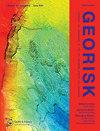A networked risk perspective for analysing debris flow losses factors considering mitigation measures
IF 4.8
3区 工程技术
Q1 ENGINEERING, GEOLOGICAL
Georisk-Assessment and Management of Risk for Engineered Systems and Geohazards
Pub Date : 2023-06-21
DOI:10.1080/17499518.2023.2222392
引用次数: 0
Abstract
ABSTRACT As debris flow disasters are becoming increasingly severe worldwide, it is necessary to deepen the research on disaster losses, especially the impact and role of disaster mitigation measures. Based on the regional disaster system theory, this paper sets an influencing factor system of debris flow losses. Then, from the perspective of networked risk, the risk propagation network is established through the Delphi method. Finally, the social network analysis method is introduced to discuss the risk propagation relationship between these factors from two aspects of the overall network analysis and node centrality analysis. The results reveal the chain-like influence characteristics of factors and clarify the main points relevant departments should emphasise in disaster risk reduction. Environmental and engineering mitigation measures strongly influence other factors, thus dominating the risk propagation in forming debris flow losses. The peril of debris flow, residents’ escape ability, and emergency rescue can be easily influenced by other factors, so increasing the resistance of these sensitive factors to the source of influence would support loss reduction. The research results can be applied to risk assessment and loss reduction of debris flow disasters.从网络风险角度分析考虑缓解措施的泥石流损失因素
本文章由计算机程序翻译,如有差异,请以英文原文为准。
求助全文
约1分钟内获得全文
求助全文
来源期刊
CiteScore
8.70
自引率
10.40%
发文量
31
期刊介绍:
Georisk covers many diversified but interlinked areas of active research and practice, such as geohazards (earthquakes, landslides, avalanches, rockfalls, tsunamis, etc.), safety of engineered systems (dams, buildings, offshore structures, lifelines, etc.), environmental risk, seismic risk, reliability-based design and code calibration, geostatistics, decision analyses, structural reliability, maintenance and life cycle performance, risk and vulnerability, hazard mapping, loss assessment (economic, social, environmental, etc.), GIS databases, remote sensing, and many other related disciplines. The underlying theme is that uncertainties associated with geomaterials (soils, rocks), geologic processes, and possible subsequent treatments, are usually large and complex and these uncertainties play an indispensable role in the risk assessment and management of engineered and natural systems. Significant theoretical and practical challenges remain on quantifying these uncertainties and developing defensible risk management methodologies that are acceptable to decision makers and stakeholders. Many opportunities to leverage on the rapid advancement in Bayesian analysis, machine learning, artificial intelligence, and other data-driven methods also exist, which can greatly enhance our decision-making abilities. The basic goal of this international peer-reviewed journal is to provide a multi-disciplinary scientific forum for cross fertilization of ideas between interested parties working on various aspects of georisk to advance the state-of-the-art and the state-of-the-practice.

 求助内容:
求助内容: 应助结果提醒方式:
应助结果提醒方式:


